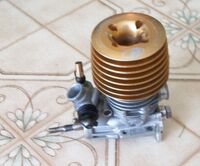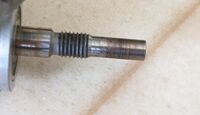An engine is a fuel powered mechanical device for providing power to an RC driveline. This is not to be confused with a motor, which is an electric motor. Interchanging the terms can be very confusing in RC, because models can be powered by either one.
Gas Engines[]
Gas engines are powered by gasoline. These are usually only used on large scale RCs (1/5 scale and bigger for land vehicles, at least). They use a spark plug and some type of ignition system to ignite the gas-air mixture to produce power.
Nitro Engines[]

Nitro engine
Nitro engines are generally tiny engines, powering small to medium size RC vehicles, and running on nitro fuel. They have relatively short lifespans, usually between 1 and 10 gallons of fuel, but there are rumours at Phroziac's local hobby shop of engines lasting 20 gallons, depending on how you care for and maintain them.
Common engine sizes for nitro land-based RC vehicles are currently between .12 and .30 cubic inches.
Nitro engine types[]
- "ABC" means the engine has no rings, and uses an aluminum piston in a tapered brass sleeve that is chrome plated. The taper and a very thin film of oil make compression. This is the only common nitro engine type used in land-based RCs.
- "Ringed" means the engine has rings around the piston. These make compression like a gas engine with tightly fitting rings between the piston and sleeve making a tight seal. This used to be more common, but some larger airplane engines are ringed.
For tuning information go here.
Crankshaft types[]
There are several different types of crankshafts in use on nitro engines. The type required is determined by the model it will be used in.
- Threaded crankshafts are the most common for small block engines. The part of the crankshaft that sticks out the front of the engine is fully threaded, except for a larger short smooth portion at the beginning where the flywheel goes. The RC model includes some type of clutch adapter. There are short cranks, long cranks, and in some cases the crank has to be cut, because the crank is too long for the clutch adapter to fit properly. The clutch adapter gives a method to attach a clutch bell to it, and are mostly smooth for the clutch bearings to ride on. They also serve as a nut to hold the flywheel on. You can cut these crankshafts if they are too long for your vehicle. You need to put the engine in a plastic bag, shove the crankshaft through the bag, put a nut on the crankshaft, and dremel the crankshaft. Use the nut to clean up the threads when you take it off. The bag will prevent debris from entering the engine.

SG crankshaft
- SG crank is the most common for racing engines. The name, SG, comes from Italian race engine manufacturer SG that introduced the crank. This type of crank is mostly smooth, with a small threaded portion in the middle for a nut to hold the flywheel on, and a larger portion where the flywheel goes. They have a small threaded hole at the end, to put a screw, usually 3mm, in, to hold the clutch bell on.
- IPS (Integrated Pilot Shaft) crank is a less common crank, mostly used on Traxxas vehicles. This is basically the same as an SG crank, but has an e-clip slot on the end to hold the clutch bell on, but they still have the threaded hole. This introduces the ease of changing a clutch bell thats held on a clip, and the ease of loosing an e-clip trying to take it off/put it on. It is a good idea to use a screw and a number of shims with the IPS cranks. If you do not want to use the method of shimming, you should at least run a screw in addition to the clip, just as a back up.
Air cooling[]
The cooling head is the most important piece of aluminum on a nitro engine. Some are big, some are small, but they all have to adequately remove heat from the engine they are designed for. They do this with specially shaped cooling fins, which transfer heat to the air. This requires airflow, which is why land engines can overheat without adequate ventilation, with holes in the body. You should generally use a hole in the windshield, over the engine, and cut most of the back out.
Aftermarket cooling heads are a very bad idea. Some people believe the cooling head that came with the engine is not cooling good enough, and get an aftermarket head. These are usually bigger, with more fins, and stick out of the body farther, which could allow more damage to occur in a rollover. Cooling heads are actually quite complicated to design, it takes more then just cutting fancy slots in a piece of aluminum. Because of this, some heads cool really close to the same, some cool worse, some cool better, and others cool so much that it underheats the engine and causes damage. The engine is designed for a specific temperature range to run properly, and the head is designed for the engine, to cool it properly. If it's overheating, there is a problem causing the overheating, and a head with more cooling capacity will just cover up the problem. Overheating is caused by improper tuning, engine defects, or improper air flow.